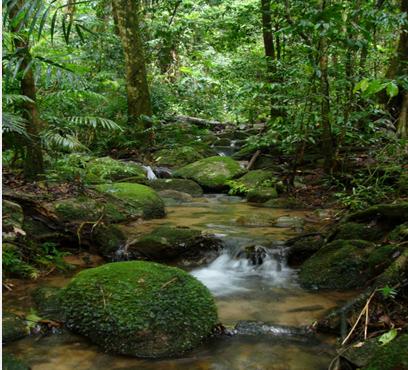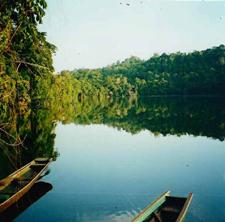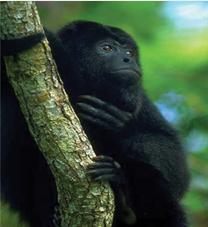The Rainforest is the Earth’s oldest living ecosystem, which is home of a immense variety of plants and animals. These breathtaking ecosystems cover only 6 % of the Earth’s surface but yet they count with more than a half of the world’s wildlife species!
A Rainforest can be described as a tall, dense jungle. The reason it is called a “rain” forest is duet to the high amount of rainfall that reach per year. The weather of the rainforest is very hot and humid and the animals and plants that live have to know how to adjust to this climate.
Rainforest of the World
* Africa
Angola
Situated on the southwest coast of Africa. There has been lost part of its large pieces of tropical rainforests duet to of “political instability and the poverty.” also there is a grand demand for rainforests to be cut down as use as wood or fuel. The rainforest gave as a result the cause of soil erosion.
Liberia
Located on the west coast of Africa. Nowadays it has lost most of its large rainforests because of harvesting and clearing for agriculture.
* South America
Brazil
Almost 40% of all the tropical rainforest in the world are in the Brazilian Amazon. This is the largest country in South America, has perhaps the best opportunity remaining to save large tracks of tropical rainforest. Brazil still has over 772,200 square miles of frontier forest.
Chile
the forest in this country seems to be situated at the end of the Earth. They form a connected island in the far reaches of the southern hemisphere, with the Pacific Ocean at the west, the Antarctic Ocean at the south, and the Andes Mountains for the east.
Ecuador
There is approximately 37% of old growth forests, which equally means close to twenty million acres. The majority is tropical rainforest situated at the east of the Andean Mountains. Also is found more than twelve thousand plant species, in this rainforest.
Peru
Rainforests of Peru contain 15,000 flowering plant, 1000 bird and 200 mammal species, including spider monkeys, yellow tailed woolly monkey, three toed sloths, tapirs, manatees, spectacled bears, otters, jaguars, pumas, caymans ans swamp crocodiles.
* Asia
One of the rainforest areas in Asia is called Malaysia. It holds many protected environments. Some of them are Kinabalu Park, Gunung Mulu Park, Taman Negara Park, and Bako Park. These parks are found in Asia and the Pacific Islands.
Taman Negara is home to more leopards than any other Malaysia rainforest. Taman Negara is a safe forest that tourists like to explore in. There are over 10,000 species of plants, 250 kinds of birds, and about 70 different mammals along with over 50 different types of reptiles in Taman Negara.
Tropical & Temperate Rainforest
There are two main kinds of rainforests Tropical Rainforest and temperate Rainforest. Those share certain characteristics and both are rich in plant and animal species.
General information
|
Tropical Rainforest |
Temperate Rainforest |
| They grow in hot places near the Equator | They grow in cool places |
| Most of the animals live in the canopy layer | Most of the animals live on the forest floor |
| Location: They are located in a broken band around the equator called the tropics. They are found in four main regions: West Africa, including Madagascar; Central and South America; etc. The Largest rainforest are located in Brazil; south America, Zaire In Africa and Indonesia y South Asia. | Location: They are found near large bodies of water, such as Oceans and Seas. They are found along Coastal areas of Chili, Great Britain; Norway, Japan, New Zealand and South Australia. The World’s largest are found around Pacific Northwest of North America, Stretching all the way from Alaska to Oregon, |
| Seasons: They do not have a dry season. | Seasons: They have different seasons like warm summers and cool winters |
| Temperature: The temperature is always warm. The average range between 68 degrees and 84 degrees Fahrenheit. (20 degrees to 29 degrees Celsius) | Temperature: the temperature ranges from 80 degrees Fahrenheit to freezing |
| Rainfall: The average is 80 to 100 inches per year | Rainfall: The average is about 100 inches |
| Largest: the Largest tropical rainforest is the Amazon, also known as the Amazonia in South America. | Largest: the Largest temperate rainforest is the Tongrass National Park in Alaska |
| Fruits: Avocado, Fig, banana, mango and Orange. | Fruits: Apple, Blueberry, pumpkins. |
| Amphibians: Poison Arrow Frog, red eyed tree frog | Amphibians: Bullfrog, spring peeper, tree frog |
| Birds: American kestrel, cattle egret, cockatoo, hummingbird, toucan, parrot, pelican, quetzal, scarlet macaw, rainbow lorikeet, red-tailed hawk, wood thrush | Birds: American Crow, American kestrel, black capped chickadee, blue jay, hummingbird, north cardinal, northern parula, red-tailed hawk, rock dove, veery, wood thrush. |
| Reptiles: Anaconda, boa constrictor, chameleon, gecko | Reptiles: Garter snake, rattlesnake |
| Insects: Leaf cutter ants, bees, large stag beetle, colorful katydids | Insects: Carpenter ants, mosquitoes. |
| Mammals: Anteater, chimpanzee, deer mouse, flying foxes, howler monkey, jaguar, kinkajou, ocelot, tamarin monkey | Mammals: black bear, badger, beaver, deer, mouse, gray squirrel, little brown myotis bat, lynx, moose, muskrat, weasel, white tailed deer. |
| Trees: Cacao tree, cecropia tree, kapok tree, teak tree, strangler fig tree | Trees: American beech, paper birch, red maple, red oak, sugar maple. |
For more information give a click at the following links.
Tropical Rainforest
Rainforest Animals
Rainforest plants
The Amazon Rainforest
It is well known that the Amazon is the lungs of the world, vegetation, and it is estimated that the first inhabitants of the Amazon basin arrived between 7000 and 5000 a. C., and the oldest remains of pottery found in the Ucayali region and date from 2000 BC. C. However, the lack of archaeological remains, in part by the rapid disintegration of the waste in the climate of tropical rainforest and the lifestyle of these cultures, generally semi-nomadic, has hampered the chronological study of the cultures of the Amazon.
The Amazon Biome is virtually unrivalled in scale, complexity and opportunity, and truly is a region distinguished by its greatness.
Not only does the Amazon contains the largest tropical rainforest in the world, also is home of at least 10% of the world’s known biodiversity, including endemic and the endangered flora and fauna, The Amazon River flows for more than 6,600 km and with its hundreds of tributaries and streams contains the largest number of freshwater fish species in the world.
For more information click at the following links
Amazon Rainforest
Amazon River Facts
Amazon Rainforest Map
Amazon Basin and Amazon Biome
The Amazon Biome, is defined as the area covered predominantly by dense moist tropical forest, with relatively small inclusions of several other types of
vegetation such as savannas, floodplain forests, grasslands, swamps, bamboos, and palm forests. The Amazon basin has over six million square kilometers, divided between overseas countries of Brazil, Peru, Ecuador, Bolivia and Venezuela. This is a tropical jungle very sparsely inhabited by the human.
Peruvian Amazon Rainforest
Peru’s Amazon Rainforest sustains the World’s richest biodiversity, in particular within the Manu, Pacaya Samiria, and Tambopata natural sanctuaries.
The Records include over 700 bird species, 1200 butterfly species, 90 mammal species, 120 reptile and amphibian species and innumerable insect species. Over 400 bird species have been recorded in these areas and there are places where it is possible to see over 100 species in a day.
Manu National Park-Amazon Rainforest
The Manu National Park is situated about 300km from the city of Cusco and forms.
The Manu National Park is probably the most biologically rich region of the Amazon Rainforest. More than 15,000 plant species grow in Manu, and as much as 250 varieties of trees have been found in a single hectare. Animal biodiversity is equally impressive:
Some 1,000 bird, 200 mammal, and 100 reptile species find shelter within its borders.
Black caimans, woolly monkeys, harpy eagles, Andean cock-of-the-rocks, giant otters, jaguars, and anteaters are some of the most intriguing and beautiful that inhabits the park’s habitats.
Although neither tourism nor tourist lodges are allowed in the park itself, visitors can stay in authorized lodges in the Cultural Zone, where several wildlife reserves, lodges and camps are open to the public.
For more information give a click on:
Puerto Maldonado
Tours
We offer a wide selection of tours click at the following:
Puerto Maldonado tours
Iquitos tours
Manu tours



